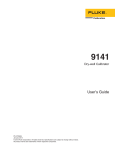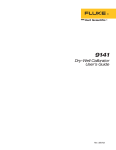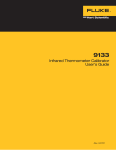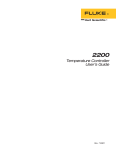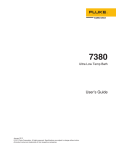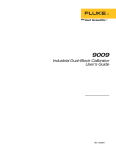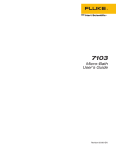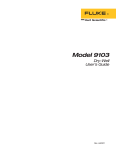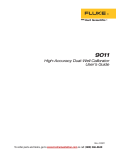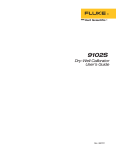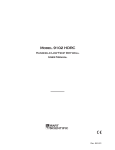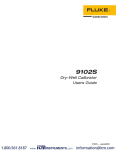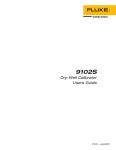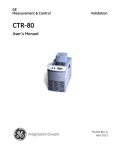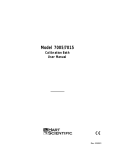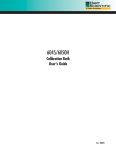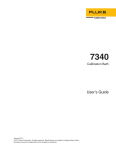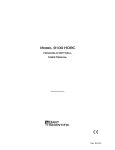Download Model 9141 - Dry-well Calibrator
Transcript
Model 9141 Dry-Well Calibrator User Manual Rev. 8A2601 © Copyright,1996 All rights reserved Hart Scientific 799 E. Utah Valley Drive American Fork, Utah 84003-9775 Telephone (801) 763-1600 • Fax (801) 763-1010 Internet: http://www.hartscientific.com WARNING To ensure the safety of operating personnel, and to avoid damage to this equipment: DO NOT operate this unit without a properly grounded, properly polarized power cord. DO NOT connect this unit to a non-grounded, non-polarized outlet. DO USE a ground fault interrupt device. WARNING HIGH VOLTAGE is used in the operation of this equipment. SEVERE INJURY OR DEATH may result if personnel fail to observe safety precautions. Before working inside the equipment, turn power off and disconnect power cord. WARNING HIGH TEMPERATURES PRESENT in this equipment FIRES AND SEVERE BURNS may result if personnel fail to observe safety precautions. a WARNING To ensure the safety of personnel, and to avoid damage to equipment: DO NOT use this unit for any application other than calibration work. DO NOT use this unit in environments other than those listed in the user’s manual. Continuous use of this equipment at high temperatures for extended periods of time requires caution. Completely unattended high temperature operation is not recommended for safety reasons. Components and heater lifetimes can be shortened by continuous high temperature operation. Follow all safety guidelines listed in the user’s manual. WARNING THIS EQUIPMENT SHOULD ONLY BE USED BY TRAINED PERSONNEL. b Table of Contents 1 Introduction. . . . . . . . . . . . . . . . . . . . . . 1 2 Specifications and Environmental Conditions . . . 3 2.1 2.2 2.3 Specifications . . . . . . . . . . . . . . . . . . . . . . . 3 Environmental Conditions . . . . . . . . . . . . . . . . 3 Warranty . . . . . . . . . . . . . . . . . . . . . . . . . 4 3 Safety Guidelines . . . . . . . . . . . . . . . . . . 5 4 Quick Start . . . . . . . . . . . . . . . . . . . . . . 7 4.1 4.2 4.3 4.4 5 Unpacking . . . . . . . Set-Up . . . . . . . . . Power . . . . . . . . . . Setting the Temperature . . . . . . . . . . . . . . . . . . . . . . . . . . . . . . . . . . . . . . . . . . . . . . . . . . . . . . . . . . . . 7 7 8 8 Bottom Panel . . . . . . . . . . . . . . . . . . . . . . . 9 Front Panel . . . . . . . . . . . . . . . . . . . . . . . 10 Constant Temperature Block Assembly . . . . . . . . . 11 5.3.1 5.3.2 Constant Temperature Block . . . . . . . . . . . . . . . . . . 11 Probe Sleeves and Tongs. . . . . . . . . . . . . . . . . . . . 12 General Operation . . . . . . . . . . . . . . . . . 13 6.1 6.2 7 . . . . Parts and Controls . . . . . . . . . . . . . . . . . . 9 5.1 5.2 5.3 6 . . . . Changing Display Units . . . . . . . . . . . . . . . . . 13 Switching to 230V Operation . . . . . . . . . . . . . . 13 Controller Operation . . . . . . . . . . . . . . . . 15 7.1 7.2 Well Temperature . . . . . . . . . . . . . . . . . . . . 15 Temperature Set-point. . . . . . . . . . . . . . . . . . 15 7.2.1 7.2.2 7.2.3 7.3 Scan . . . . . . . . . . . . . . . . . . . . . . . . . . . 17 7.3.1 7.3.2 7.4 Scan Control . . . . . . . . . . . . . . . . . . . . . . . . . . 18 Scan Rate . . . . . . . . . . . . . . . . . . . . . . . . . . . . 18 Temperature Display Hold . . . . . . . . . . . . . . . . 18 7.4.1 7.4.2 7.4.3 7.4.4 7.5 7.6 7.7 Programmable Set-points . . . . . . . . . . . . . . . . . . . . 15 Set-point Value . . . . . . . . . . . . . . . . . . . . . . . . . 17 Temperature Scale Units . . . . . . . . . . . . . . . . . . . . 17 Hold Temperature Display Mode Setting . . . . . . . Switch Wiring . . . . . . . Switch Test Example . . . . . . . . . . . . . . . . . . . . . . . . . . . . . . . . . . . . . . . . . . . . . . . . . . . . . . . . . . . . . . . . . . . . . . . . . . . . . . . 19 19 19 19 Secondary Menu . . . . . . . . . . . . . . . . . . . . 20 Heater Power . . . . . . . . . . . . . . . . . . . . . . 20 Proportional Band . . . . . . . . . . . . . . . . . . . . 21 i 7.8 7.9 Controller Configuration . . . . . . . . . . . . . . . . . 22 Calibration Parameters . . . . . . . . . . . . . . . . . 22 7.9.1 7.9.2 7.9.3 R0 . . . . . . . . . . . . . . . . . . . . . . . . . . . . . . . . 22 ALPHA . . . . . . . . . . . . . . . . . . . . . . . . . . . . . 23 DELTA. . . . . . . . . . . . . . . . . . . . . . . . . . . . . . 23 7.10 Operating Parameters . . . . . . . . . . . . . . . . . . 23 7.11 Serial Interface Parameters . . . . . . . . . . . . . . . 23 7.11.1 7.11.2 7.11.3 7.11.4 8 BAUD Rate . . Sample Period Duplex Mode . Linefeed . . . . . . . . . . . . . . . . . . . . . . . . . . . . . . . . . . . . . . . . . . . . . . . . . . . . . . . . . . . . . . . . . . . . . . . . . . . . . . . . . . . . . . . . . . . . . . . . . . . . 24 24 24 25 Digital Communication Interface . . . . . . . . . 27 8.1 Serial Communications . . . . . . . . . . . . . . . . . 27 8.1.1 8.1.2 Wiring . . . . . . . . . . Setup . . . . . . . . . . 8.1.2.1 BAUD Rate . . 8.1.2.2 Sample Period 8.1.2.3 Duplex Mode . 8.1.2.4 Linefeed . . . 8.1.3 Serial Operation. . . . . 8.2 9 . . . . . . . . . . . . . . . . . . . . . . . . . . . . . . . . . . . . . . . . . . . . . . . . . . . . . . . . . . . . . . . . . . . . . . . . . . . . . . . . . . . . . . . . . . . . . . . . . . . . . . . . . . . . . . . . . . . . . . . . . . . . . . . . . . . . . . . . . . . . . . . . 27 28 28 28 28 28 30 Interface Commands . . . . . . . . . . . . . . . . . . 30 Test Probe Calibration . . . . . . . . . . . . . . . 31 9.1 9.2 Calibrating a Single Probe. . . . . . . . . . . . . . . . 31 Dry-well Characteristics . . . . . . . . . . . . . . . . . 31 9.2.1 9.2.2 Heating and Cooling Rates . . . . . . . . . . . . . . . . . . . 31 Stabilization and Accuracy . . . . . . . . . . . . . . . . . . . 31 10 Calibration Procedure . . . . . . . . . . . . . . . 35 10.1 Calibration Points . . . . . . . . . . . . . . . . . . . . 35 10.2 Calibration Procedure . . . . . . . . . . . . . . . . . . 35 10.2.1 Compute DELTA: . . . . . . . . . . . . . . . . . . . . . . . . 35 10.2.2 Compute R0 & ALPHA: . . . . . . . . . . . . . . . . . . . . . 36 10.2.3 Accuracy & Repeatability . . . . . . . . . . . . . . . . . . . . 37 11 Maintenance. . . . . . . . . . . . . . . . . . . . . 39 12 Trouble Shooting . . . . . . . . . . . . . . . . . . 41 12.1 Troubleshooting . . . . . . . . . . . . . . . . . . . . . 41 12.2 Wiring Diagram . . . . . . . . . . . . . . . . . . . . . 43 12.3 CE Comments . . . . . . . . . . . . . . . . . . . . . . 44 12.3.1 EMC Directive. . . . . . . . . . . . . . . . . . . . . . . . . . 44 12.3.2 Low Voltage Directive (Safety) . . . . . . . . . . . . . . . . . 44 ii Figures and Tables Figure 1 Figure 2 Figure 3 Figure 4 Figure 5 Figure 6 Table 1 Table 1 Figure 7 Figure 8 Figure 9 Heat shield installed on 9141calibrator. . . . . . . . . . . . 6 9141 Back Panel and Bottom . . . . . . . . . . . . . . . . 9 9141 Front Panel . . . . . . . . . . . . . . . . . . . . . . 10 Inserts available for the 9141 block assembly . . . . . . . 11 Controller Operation Flowchart . . . . . . . . . . . . . . . 16 Serial Cable Wiring . . . . . . . . . . . . . . . . . . . . . 27 9141 controller communications commands . . . . . . . . 29 9141 communication commands continued . . . . . . . . 30 Typical Heating Rate . . . . . . . . . . . . . . . . . . . . 33 Typical Cooling Rate . . . . . . . . . . . . . . . . . . . . 33 Wiring Diagram . . . . . . . . . . . . . . . . . . . . . . . 43 iii 1 Introduction 1 Introduction The Hart Scientific Model 9141 High-Temp Field Calibrator may be used as a portable instrument or bench top temperature calibrator for calibrating thermocouple and RTD temperature probes. The 9141 is small enough to use in the field, and accurate enough to use in the lab. Calibrations may be done over a range of 50°C to 650°C (122°F to 1202°F). Temperature display of the 9141 is 0.1 degrees. The dry-well calibrator features: • Rapid heating and cooling • Interchangeable multiple hole probe sleeves • Convenient handle • RS-232 interface • Switchable AC Input (115 VAC or 230 VAC) Built in programmable features include: • Temperature scan rate control • Temperature switch hold • Eight Setpoint memory • Adjustable readout in °C or °F The temperature is accurately controlled by Hart’s hybrid analog/digital controller. The controller uses a precision platinum RTD as a sensor and controls the well temperature with a solid state relay (triac) driven heater. The LED front panel continuously shows the current well temperature. The temperature may be easily set with the control buttons to any desired temperature within the specified range. The calibrator’s multiple fault protection devices insure user and instrument safety and protection. The 9141 dry-well calibrator was designed for portability, low cost, and ease of operation. Through proper use, the instrument will provide continued accurate calibration of temperature sensors and devices. The user should be familiar with the safety guidelines and operating procedures of the calibrator as described in the instruction manual. 9141 Manual Rev. 8A2601 1 2 Specifications and Environmental Conditions 2 2.1 2.2 Specifications and Environmental Conditions Specifications Power 115 VAC (±10%), 50–60 Hz, 1000 Watts and 230 VAC (±10%), 50–60 Hz, switchable Ambient Temperature 5–50°C(41–121°F) Operating Range 50–650°C (122–1202°F) Resolution 0.1°C or °F resolution Readout Switchable °C or °F Accuracy ±0.5°C up to 400°C, ±1°C 400°C to 650°C, ±2°C holes greater then 6.5 mm (0.25”) Stability ±0.1°C to 400°C, ±0.2°C above 400°C Uniformity 50°C to 400°C: ±0.4°C typical ±0.5°C with similar sized wells above 400°C Controller Hybrid analog/digital controller with data retention Heater 1000 W Heating Times 12 minutes from ambient to 650°C Cooling Times 25 minutes from 650°C to 100°C Stabilization Time 7 minutes Immersion Depth 124 mm (4.875”) Cooling 2 speed internal fan Fault Protection Sensor burnout and short protection, over temperature thermal cutout Test Wells 1.125" dia. x 4.87" deep. Multi-hole inserts are available. Size 229 mm H x 114 mm W x 178mm D (9" x 4.5" x 7") Weight 3.6 kg (8 lbs.) Environmental Conditions Although the instrument has been designed for optimum durability and trouble-free operation, it must be handled with care. The instrument should not be 9141 Manual Rev. 8A2601 3 2 Specifications and Environmental Conditions operated in an excessively dusty or dirty environment. Maintenance and cleaning recommendations can be found in the Maintenance Section of this manual. The instrument operates safely under the following conditions: • temperature range: 5 - 50°C (41 - 122°F) • ambient relative humidity: 15 - 50% • pressure: 75kPa - 106kPa • mains voltage within ± 10% of nominal • vibrations in the calibration environment should be minimized • altitude does not effect the performance or safety of the unit 2.3 Warranty Hart Scientific, Inc. (Hart) warrants this product to be free from defects in material and workmanship under normal use and service for a period as stated in our current product catalog from the date of shipment. This warranty extends only to the original purchaser and shall not apply to any product which, in Hart’s sole opinion, has been subject to misuse, alteration, abuse or abnormal conditions of operation or handling. Software is warranted to operate in accordance with its programmed instructions on appropriate Hart products. It is not warranted to be error free. Hart’s obligation under this warranty is limited to repair or replacement of a product which is returned to Hart within the warranty period and is determined, upon examination by Hart, to be defective. If Hart determines that the defect or malfunction has been caused by misuse, alteration, abuse or abnormal conditions or operation or handling, Hart will repair the product and bill the purchaser for the reasonable cost of repair. To exercise this warranty, the purchaser must forward the product after calling or writing Hart for authorization. Hart assumes NO risk for in-transit damage. For service or assistance, please contact the manufacturer. Hart Scientific, Inc. 799 East Utah Valley Drive American Fork, UT 84003-9775 Phone: (801) 763-1600 Fax: (801) 763-1010 E-mail: [email protected] THE FOREGOING WARRANTY IS PURCHASER’S SOLE AND EXCLUSIVE REMEDY AND IS IN LIEU OF ALL OTHER WARRANTIES, EXPRESS OR IMPLIED, INCLUDING BUT NOT LIMITED TO ANY IMPLIED WARRANTY OR MERCHANTABILITY, OR FITNESS FOR ANY PARTICULAR PURPOSE OR USE. HART SHALL NOT BE LIABLE FOR ANY SPECIAL, INDIRECT, INCIDENTAL, OR CONSEQUENTIAL DAMAGES OR LOSS WHETHER IN CONTRACT, TORT, OR OTHERWISE. 4 Manual Rev. 8A2601 Hart Scientific 3 Safety Guidelines 3 Safety Guidelines • Operate the instrument in room temperatures between 5–50°C (41-122°F). Allow sufficient air circulation by leaving at least 15 cm (6 inches) of space between the instrument and nearby objects. Overhead clearance 45 cm (18 inches) to allow for safe and easy insertion and removal of probes for calibration. • The dry-well is a precision instrument. Although it has been designed for optimum durability and trouble free operation, it must be handled with care. Always carry the unit in an upright position to prevent the probe sleeves from dropping out. The convenient fold-up handle allows one hand carrying. The instrument should not be operated in excessively wet, oily, dusty, or dirty environments. It is important to keep the well of the instrument clean and clear of any foreign matter. Do not operate near flammable materials. • DO NOT use fluids to clean out the well. • The instrument can generate extreme temperatures. Precautions must be taken to prevent personal injury or damage to objects. Probes may be extremely hot or cold when removed from the instrument. Cautiously handle probes to prevent personal injury. Always use the special sleeve tongs that are supplied with the calibrator to remove the sleeve. Carefully place probes on a heat/cold resistant surface or rack until they are at room temperature. Never place any objects other than the special probe sleeves supplied with the calibrator into the well. • Use only a grounded AC mains supply of the appropriate voltage to power the instrument. The dry-well requires 10 amps at 115 VAC (±10%), 50-60 Hz, 5 amps at 230 VAC (±10%). • Before initial use, after transport, and anytime the dry-well has not been energized for more than 10 days, the instrument needs to be energized for a “dry-out” period of 1-2 hours before it can be assumed to meet all of the safety requirements of the IEC 1010-1. • The instrument is equipped with operator accessible fuses. If a fuse blows, it may be due to a power surge or failure of a component. Replace the fuse once. If the fuse blows a second time, it is likely caused by failure of a component part. If this occurs, contact Hart Scientific Customer Service. Always replace the fuse with one of the same rating, voltage, and type. Never replace the fuse with one of a higher current rating. • If a mains supply power fluctuation occurs, immediately turn off the instru- ment. Power bumps from brown-outs and black-outs could damage the instrument. Wait until the power has stabilized before re-energizing the instrument. • Hart Scientific strongly recommends using the heat shield (Figure 1) provided while operating the calibrator at temperatures above 200°C. The heat shield protects the hub on the probes from heat and reduces the risk of the user being burned by the hub. The heat shield gets very hot and does not prevent all heat from reaching the hub. Be careful when removing the heat shield or the probe from the well. 9141 Manual Rev. 8A2601 5 3 Safety Guidelines Figure 1 Heat shield installed on 9141calibrator 6 Manual Rev. 8A2601 Hart Scientific 4 Quick Start 4 4.1 Quick Start Unpacking Unpack the dry-well carefully and inspect it for any damage that may have occurred during shipment. If there is shipping damage, notify the carrier immediately. Verify that the following components are present: • 9141 Dry-well • 3141-2, Insert A • Power Cord • Manual • Heat Shield • 9930 • RS-232 Cable • Removal Tool 4.2 Set-Up Place the calibrator on a flat surface with at least 6 inches of free space around and 18 inches above the instrument. Plug the power cord into a grounded mains outlet. Observe that the nominal voltage corresponds to that indicated on the back of the calibrator. Place the heat shield on the unit to deflect high temperatures from the probe hubs. CAUTION: The heat shield may become very hot. Use extreme caution. Carefully insert the probe sleeve into the well. (DO NOT drop the sleeve in the well.) Probe sleeve holes should be of the smallest diameter possible while still allowing the probe to slide in and out easily. Sleeves with various hole sizes are available from Hart Scientific. The well must be clear of any foreign objects, dirt and grit before the sleeve is inserted. The sleeve is inserted with the two small tong holes positioned upward. Turn on the power to the calibrator by toggling the switch on the power entry module. The fan should begin quietly blowing air through the instrument and the controller display should illuminate after 3 seconds. After a brief self test the controller should begin normal operation. If the unit fails to operate please check the power connection. The display will begin to show the well temperature and the well heater will start operating to bring the temperature of the well to the set-point temperature. 9141 Manual Rev. 8A2601 7 4 Quick Start 4.3 Power Plug the dry-well power cord into a mains outlet of the proper voltage, frequency, and current capability. Typically this will be 115 VAC (±10%), 50/60 Hz (230 VAC (±10%), 50/60 Hz). Turn the dry-well on using the rear panel “POWER” switch. The dry-well will turn on and begin to heat to the previously programmed temperature set-point. The front panel LED display will indicate the actual dry-well temperature. 4.4 Setting the Temperature Section 7.2 explains in detail how to set the temperature set-point on the calibrator using the front panel keys. The procedure is summarized here. (1) Press “SET” twice to access the set-point value. (2) Press “UP” or “DOWN” to change the set-point value. (3) Press “SET” to store the new set-point. (4) Press “EXIT” to return to the temperature display. When the set-point temperature is changed the controller will switch the well heater on or off to raise or lower the temperature. The displayed well temperature will gradually change until it reaches the set-point temperature. The well may require 5 to 10 minutes to reach the set-point depending on the span. Another 5 to 10 minutes is required to stabilize within ±0.1°C of the set-point. Ultimate stability may take 15 to 20 minutes more of stabilization time. 8 Manual Rev. 8A2601 Hart Scientific 5 Parts and Controls 5 Parts and Controls The user should become familiar with the dry-well calibrator and its parts. 5.1 Bottom Panel Figure 2 on page 9. Power Cord - Underneath the calibrator is the removable power cord inlet that plugs into an IEC grounded socket. Power Switch - The power switch is located on the power entry module (PEM). The PEM also houses the fuses and the dual voltage selector. The PEM and Heater Voltage Switch (see below) allow the unit to be field switchable for 115 VAC (±10%) or 230 VAC (±10%) operation. 115V RS-232 115 VAC/10A 230 VAC/5A 50/60 Hz 115V 115V - 10A F 250V 230V - 5A F 250V 115 VAC/10A 230 VAC/5A 50/60 0/60 Hz HEATER VOLTAGE SWITCH 115V 115V 15V - 10A F 250V 230V 30V - 5A F 250V Back View Bottom View Figure 2 9141 Back Panel and Bottom 9141 Manual Rev. 8A2601 9 5 Parts and Controls Heater Voltage Switch - To be used only when changing the input voltage. (See Section 6.2 for instructions on changing the input voltage.) Note: The input voltage and heater voltage switch settings should always be the same value. Serial Port - A DB-9 male connector is present for interfacing the calibrator to a computer or terminal with serial RS-232 communications. Fan - The fan inside the calibrator runs continuously when the unit is being operated to provide cooling for the instrument. It has two speeds, a slow speed for control operation and a faster speed for rapid cooling. Slots at the top and around the two corners of the calibrator are provided for airflow. The area around the calibrator must be kept clear to allow adequate ventilation. The airflow is directed upward and can be extremely hot. 5.2 Front Panel Figure 3 on page 10. Controller Display - The digital display is an important part of the temperature controller because it not only displays set and actual temperatures but also various calibrator functions, settings, and constants. The display shows temperatures in units according to the selected scale °C or °F. Controller Keypad - The four button keypad allows easy setting of the set-point temperature. The control buttons (SET, DOWN, UP, and EXIT) are used to set the calibrator temperature set-point, access and set other operating parameters, and access and set calibration parameters. Setting the control temperature is done directly in degrees of the current scale. It can be set to one-tenth of a degree Celsius or Fahrenheit. The functions of the buttons are as follows: 650.0 C SWITCH HOLD SET HART SCIENTIFIC DOWN UP EXIT 9141 EZT Figure 3 9141 Front Panel 10 Manual Rev. 8A2601 Hart Scientific 5 Parts and Controls SET – Used to display the next parameter in the menu and to store parameters to the displayed value. DOWN – Used to decrement the displayed value of parameters. UP – Used to increment the displayed value. EXIT – Used to exit a function and skip to the next function. Any changes made to the displayed value are ignored. 5.3 Constant Temperature Block Assembly Figure 4 on page 11. 5.3.1 Constant Temperature Block The “Block” is made of aluminum-bronze and provides a relatively constant and accurate temperature environment for the sensor that is to be calibrated. A 28.6 mm (1.125-inch) diameter well is provided that may be used for sensors of that size or may be sleeved down with various sized multi-hole probe sleeves. Heaters surround the block assembly and provide even heat to the sensor. A high-temperature platinum RTD is imbedded at the base of the block assembly to sense and control the temperature of the block. The entire assembly is suspended in an air cooled chamber thermally isolated from the chassis and electronics. CAUTION: The block vent cover may be very hot due to the fan blowing upward. Please use caution. 1/4" 1/16" 1/2" 3/8" 3/8" 3/8" 3/16" 1/8" 1/4" 1/4" 3/16" 3/16" 1/4" Insert A Insert B Insert C Figure 4 Inserts available for the 9141 block assembly 9141 Manual Rev. 8A2601 11 5 Parts and Controls 5.3.2 Probe Sleeves and Tongs The calibrator is supplied with a multi-hole aluminum-bronze probe sleeve for insertion into the calibrator well and tongs for removing sleeves. Probe sleeves of various hole sizes are available to allow the user’s probe to fit snugly into the well whatever the diameter of the probe. One insert, whichever is ordered, is shipped with the unit: • Insert A (variety block): 1/2”, 3/8”,3/16”,1/8”, and 1/16” holes • Insert B (comparison block): 2 3/8”,2 1/4”, and 2 3/16” holes or • Insert C (1/4” comparison block): 6 1/4” holes 12 Manual Rev. 8A2601 Hart Scientific 6 General Operation 6 General Operation 6.1 Changing Display Units The 9141 can display temperature in Celsius or Fahrenheit. The temperature units are shipped from the factory set to Celsius. To change to Fahrenheit or back to Celsius there are two ways: 1 - Press the “SET” and “UP” simultaneously. This will change display units. 2 - Press the “SET” key three times from the temperature display to show Un= C Press the “UP” or “Down” key to change units. Press “SET” to store changes. 6.2 Switching to 230V Operation The 9141 is switchable from 115 VAC to 230 VAC 50/60 Hz. Switching the voltage can change the calibration, so the unit should be calibrated after changing the input voltage. To change from 115 VAC to 230 VAC: • Unplug the unit. • Lay the unit down on its side. • With a small straight slot screwdriver remove the fuse holder located on the rear panel. Replace the two fuses (10 amp 250 V) with 5 amp 250V fuses. • Replace the fuse holder with the “230V” in the display window. • Using the same straight slot screwdriver, move the heater switch to display “230V”. See the rear panel drawing in Figure 2 on page 9. Note: If the heater switch and the fuse holder do not both read 230V when complete, the unit will either not heat or only heat at a fraction of its capacity. If not done properly, the unit could become damaged and void the calibration and warranty. Use 10 amp fuses for 115V and 5 amp for 230V only. DO NOT PLUG THE UNIT INTO 230 V IF THE HEATER SWITCH AND FUSE HOLDER READ 115. THIS WILL CAUSE THE FUSES TO BLOW AND MAY DAMAGE THE INSTRUMENT. 9141 Manual Rev. 8A2601 13 7 Controller Operation 7 Controller Operation This chapter discusses in detail how to operate the dry-well temperature controller using the front control panel. Using the front panel key-switches and LED display the user may monitor the well temperature, set the temperature set-point in degrees C or F, monitor the heater output power, adjust the controller proportional band, and program the calibration parameters, operating parameters, and serial interface configuration. Operation of the functions and parameters are shown in the flowchart in Figure 5 on page 16. This chart may be copied for reference. In the following discussion a button with the word SET, UP, EXIT or DOWN inside indicates the panel button while the dotted box indicates the display reading. Explanation of the button or display reading are to the right of each button or display value. 7.1 Well Temperature The digital LED display on the front panel allows direct viewing of the actual well temperature. This temperature value is what is normally shown on the display. The units, C or F, of the temperature value are displayed at the right. For example, 100.0 C Well temperature in degrees Celsius The temperature display function may be accessed from any other function by pressing the “EXIT” button. 7.2 Temperature Set-point The temperature set-point can be set to any value within the range and resolution as given in the specifications. Be careful not to exceed the safe upper temperature limit of any device inserted into the well. Setting the temperature involves two steps: (1) select the set-point memory and (2) adjust the set-point value. 7.2.1 Programmable Set-points The controller stores 8 set-point temperatures in memory. The set-points can be quickly recalled to conveniently set the calibrator to a previously programmed temperature set-point. To set the temperature one must first select the set-point memory. This function is accessed from the temperature display function by pressing “SET”. The number of the set-point memory currently being used is shown at the left on the display followed by the current set-point value. 100.0 C 9141 Well temperature in degrees Celsius Manual Rev. 8A2601 15 7 Controller Operation Display Temperature UP Switch Hold Display Mode DOWN SET SET Select Setpoint EXIT + DOWN Toggles Display of Rs SET SET Adjust Setpoint EXIT + UP Toggles °C / °F SET Secondary Functions Units °C/°F EXIT SET SET + EXIT Scan On/Off EXIT EXIT Display Power SET SET Scan Rate EXIT EXIT Set Proportional Band SET SET EXIT Configuration Menu SET EXIT EXIT UP Cal Menu SET DOWN Operating Parameters Menu X5 R0 SET EXIT EXIT UP DOWN Serial Interface Menu SET SET HL BAUD Rate SET EXIT SET Adj. R0 Adj. HL Adjust BAUD Rate SET/EXIT SET/EXIT SET/EXIT Sample Period ALPHA SET EXIT SET EXIT Adj. Sample Period Adj. ALPHA SET/EXIT SET/EXIT DELTA Duplex Mode SET EXIT EXIT SET Adj. DELTA Adj. Duplex Mode SET/EXIT SET/EXIT EXIT Linefeed SET EXIT Adjust Linefeed SET/EXIT Figure 5 Controller Operation Flowchart 16 Manual Rev. 8A2601 Hart Scientific 7 Controller Operation S Access set-point memory 1. 100. Set-point memory 1, 100°C currently used To change to another set-point memory press “UP” or “DOWN”. 4. 300. New set-point memory 4, 300°C Press “SET” to accept the new selection and access the set-point value. S 7.2.2 Accept selected set-point memory Set-point Value The set-point value may be adjusted after selecting the set-point memory and pressing “SET”. 4 200. Set-point 4 value in°C If the set-point value is correct then press “EXIT” to resume displaying the well temperature. To change the set-point values, press “SET” and then press “UP” or “DOWN” to adjust the set-point value. 220. New set-point value When the desired set-point value is reached press “SET” to accept the new value and access the temperature scale units selection. If “EXIT” is pressed instead then any changes made to the set-point will be ignored. S 7.2.3 Accept new set-point value Temperature Scale Units The temperature scale units of the controller maybe set by the user to degrees Celsius (°C) or Fahrenheit (°F). The units are used in displaying the well temperature, set-point, and proportional band. Press “SET” after adjusting the set-point value to change display units. Un= C Scale units currently selected Press “UP” or “DOWN” to change the units. Un= F 7.3 New units selected Scan The scan rate can be set and enabled so that when the set-point is changed the dry-well heats or cools at a specified rate (degrees per minute) until it 9141 Manual Rev. 8A2601 17 7 Controller Operation reaches the new set-point. With the scan disabled the dry-well heats or cools at the maximum possible rate. 7.3.1 Scan Control The scan is controlled with the scan on/off function that appears in the main menu after the temperature scale units. Sc=OFF Scan function off Press “UP” or “DOWN” to toggle the scan on or off. Sc=On Scan function on Press “SET” to accept the present setting and continue. S 7.3.2 Accept scan setting Scan Rate The next function in the main menu is the scan rate. The scan rate can be set from .1 to 99.9°C/min. The maximum scan rate however is actually limited by the natural heating or cooling rate of the instrument. This is often less than 100°C/min, especially when cooling. The scan rate function appears in the main menu after the scan control function. The scan rate units are in degrees per minute, degrees C or F depending on the selected units. Sr= 10.0 Scan rate in°C/min Press “UP” or “DOWN” to change the scan rate. Sr= 2.0 New scan rate Press “SET” to accept the new scan rate and continue. S 7.4 Accept scan rate Temperature Display Hold The 9141 has a display hold function which allows action of an external switch to freeze the displayed temperature and stop the set-point from scanning. This is useful for testing thermal switches and cutouts. This section explains the functions available for operating the temperature hold feature. An example follows showing how to set up and use the hold feature to test a switch. 18 Manual Rev. 8A2601 Hart Scientific 7 Controller Operation 7.4.1 Hold Temperature Display The hold feature is enabled by simply pressing the “UP” button. The hold temperature display shows the hold temperature on the right and the switch status on the left. For the status “c” means the switch is closed and “o” means the switch is open. The status flashes when the switch is in its active position (opposite the normal position). The hold temperature shows what the temperature of the well was when the switch changed from its normal position to its active position. While the switch is in the normal position the hold temperature will follow the well temperature. Operation of the hold temperature display is outlined below. 143.5 C U Well temperature display Access hold display c 144.8 Switch status and hold temperature To return to the normal well temperature display press “DOWN”. 7.4.2 Mode Setting The Hold Function is always in the automatic mode. In this mode the normal position is set to whatever the switch position is when the set-point is changed. For example, if the switch is currently open when the set-point is changed, the closed position then becomes the new active position. The normal position is set automatically under any of the following conditions, (1) a new set-point number is selected, (2) the set-point value is changed, (3) a new set-point is set through the communications channels. The operating mode of the temperature hold is set in the primary menu after the scan rate setting. 7.4.3 Switch Wiring The thermal switch or cutout is wired to the calibrator at the two terminals in the front of the dry-well calibrator labeled “SWITCH HOLD”. The switch wires may be connected to the terminals either way. Internally the black terminal connects to ground. The red terminal connects to +5V through a 100 kΩ resistor. The calibrator measures the voltage at the red terminal and interprets +5V as open and 0V as closed. 7.4.4 Switch Test Example This section describes a possible application for the temperature hold feature and how the instrument is set up and operated. Suppose you have a thermal switch which is supposed to open at about 75°C and close at about 50°C and you want to test the switch to see how accurate and repeatable it is. You can use the temperature hold feature and the scan function to test the switch. Measurements can be made by observing the dis- 9141 Manual Rev. 8A2601 19 7 Controller Operation play or, preferably, by collecting data using a computer connected to the RS-232 port. To set up the test do the following steps. 1. Connect the switch wires to the terminals on the front of the dry-well and place the switch in the well. 2. Enable set-point scanning by setting the scan to “ON” in the primary menu (see section 7.3.1). 3. Set the scan rate to a low value, say 1.0°C/min. (see section 7.3.2). If the scan rate is too high you may lose accuracy because of transient temperature gradients. If the scan rate is too low the duration of the test may be longer than is necessary. You may need to experiment to find the best scan rate. 4. Set the first program set-point to a value below the expected lower switch temperature, say 40°C, in the program menu. 5. Set the second program set-point to a value above the expected upper switch temperature, say 90°C. 6. Set the program soak time to allow enough time to collect a number of data points, say 2 minutes. 7. Collect data on a computer connected to the RS-232 port. Refer to Section 8 for instructions on configuring the RS-232 communications interface. 7.5 Secondary Menu Functions which are used less often are accessed within the secondary menu. The secondary menu is accessed by pressing “SET” and “EXIT” simultaneously and then releasing. The first function in the secondary menu is the heater power display. (See Figure 5 on page 16.) 7.6 Heater Power The temperature controller controls the temperature of the well by pulsing the heater on and off. The total power being applied to the heater is determined by the duty cycle or the ratio of heater on time to the pulse cycle time. By knowing the amount of heating the user can tell if the calibrator is heating up to the set-point, cooling down, or controlling at a constant temperature. Monitoring the percent heater power will let the user know how stable the well temperature is. With good control stability the percent heating power should not fluctuate more than ±1% within one minute. The heater power display is accessed in the secondary menu. Press “SET” and “EXIT” simultaneously and release. The heater power will be displayed as a percentage of full power. 100.0 C S+E SEC 20 Well temperature Access heater power in secondary menu Flashes power for secondary menu and then displays the heater Manual Rev. 8A2601 Hart Scientific 7 Controller Operation 12.0 P Heater power in percent To exit out of the secondary menu press “EXIT”. To continue on to the proportional band setting function press “SET”. 7.7 Proportional Band In a proportional controller such as this the heater output power is proportional to the well temperature over a limited range of temperatures around the set-point. This range of temperature is called the proportional band. At the bottom of the proportional band the heater output is 100%. At the top of the proportional band the heater output is 0. Thus as the temperature rises the heater power is reduced, which consequently tends to lower the temperature back down. In this way the temperature is maintained at a fairly constant temperature. The temperature stability of the well and response time depend on the width of the proportional band. If the band is too wide the well temperature will deviate excessively from the set-point due to varying external conditions. This is because the power output changes very little with temperature and the controller cannot respond very well to changing conditions or noise in the system. If the proportional band is too narrow the temperature may swing back and forth because the controller overreacts to temperature variations. For best control stability the proportional band must be set for the optimum width. The proportional band width is set at the factory to about 15.0°C. The proportional band width may be altered by the user if he desires to optimize the control characteristics for a particular application. The proportional band width is easily adjusted from the front panel. The width may be set to discrete values in degrees C or F depending on the selected units. The proportional band adjustment is be accessed within the secondary menu. Press “SET” and “EXIT” to enter the secondary menu and show the heater power. Then press “SET” to access the proportional band. S+E SEC 12.0 P S Access heater power in secondary menu Flashes power for secondary menu and then displays the heater Heater power in percent Access proportional band 4.1 ProP Proportional band setting Flashes and then displays the value To change the proportional band press “UP” or “DOWN”. 10.0 9141 New proportional band setting Manual Rev. 8A2601 21 7 Controller Operation To accept the new setting press “SET”. Press “EXIT” to continue without storing the new value. S 7.8 Accept the new proportional band setting Controller Configuration The controller has a number of configuration and operating options and calibration parameters which are programmable via the front panel. These are accessed from the secondary menu after the proportional band function by pressing “SET”. Pressing “SET” again enters the first of three sets of configuration parameters — calibration parameters, operating parameters and serial interface parameters. The sets are selected using the “UP” and “DOWN” keys and then pressing “SET”. (See Figure 5 on page 16.) 7.9 Calibration Parameters The operator of the instrument controller has access to a number of the calibration constants namely R0, ALPHA, and DELTA. These values are set at the factory and must not be altered. The correct values are important to the accuracy and proper and safe operation of the instrument. Access to these parameters is available to the user so that in the event that the controller memory fails the user may restore these values to the factory settings. The user should have a list of these constants and their settings with the instrument manual. DO NOT change the values of the instrument calibration constants from the factory set values. The correct setting of these parameters is important to the safety and proper operation of the instrument. The calibration parameters menu is indicated by, CAL Calibration parameters menu Press “SET” five times to enter the menu. The calibration parameters menu contains the parameters, R0, ALPHA, and DELTA, which characterize the resistance-temperature relationship of the platinum control sensor. These parameters may be adjusted to improve the accuracy of the calibrator. The calibration parameters are accessed by pressing “SET” after the name of the parameter is displayed. The value of the parameter may be changed using the “UP” and “DOWN” buttons. After the desired value is reached press “SET” to set the parameter to the new value. Pressing “EXIT” causes the parameter to be skipped ignoring any changes that may have been made. 7.9.1 R0 This probe parameter refers to the resistance of the control probe at 0°C. The value of this parameter is set at the factory for best instrument accuracy. 22 Manual Rev. 8A2601 Hart Scientific 7 Controller Operation 7.9.2 ALPHA This probe parameter refers to the average sensitivity of the probe between 0 and 100°C. The value of this parameter is set at the factory for best instrument accuracy. 7.9.3 DELTA This probe parameter characterizes the curvature of the resistance-temperature relationship of the sensor. The value of this parameter is set at the factory for best instrument accuracy. 7.10 Operating Parameters The operating parameters menu is indicated by, PAr Operating parameters menu Press “UP” to enter the menu. The operating parameters menu contains the HL (High Limit) parameter. The HL parameter adjusts the upper set-point temperature. The factory default and maximum are set to 650°C. For safety, a user can adjust the HL down so the maximum temperature set-point is restricted. HL High Limit parameter Press “SET” to enable adjustment of HL H=650 Current HL setting Adjust the HL parameter using “UP” or “DOWN”. H=400 New HL setting Pres “SET” to accept the new temperature limit. 7.11 Serial Interface Parameters The serial RS-232 interface parameters menu is indicated by, SErIAL Serial RS-232 interface parameters menu The serial interface parameters menu contains parameters which determine the operation of the serial interface. These controls only apply to instruments fitted with the serial interface. The parameters in the menu are — BAUD rate, sample period, duplex mode, and linefeed. 9141 Manual Rev. 8A2601 23 7 Controller Operation 7.11.1 BAUD Rate The BAUD rate is the first parameter in the menu. The BAUD rate setting determines the serial communications transmission rate. The BAUD rate parameter is indicated by, bAUd Serial BAUD rate parameter Press “SET” to choose to set the BAUD rate. The current BAUD rate value will then be displayed. 2400 b Current BAUD rate The BAUD rate of the serial communications may be programmed to 300, 600, 1200, 2400, 4800, or 9600 BAUD. Use “UP” or “DOWN” to change the BAUD rate value. 4800 b New BAUD rate Press “SET” to set the BAUD rate to the new value or “EXIT” to abort the operation and skip to the next parameter in the menu. 7.11.2 Sample Period The sample period is the next parameter in the serial interface parameter menu. The sample period is the time period in seconds between temperature measurements transmitted from the serial interface. If the sample rate is set to 5, the instrument transmits the current measurement over the serial interface approximately every five seconds. The automatic sampling is disabled with a sample period of 0. The sample period is indicated by, SPer Serial sample period parameter Press “SET” to choose to set the sample period. The current sample period value will be displayed. Press “EXIT” to exit without saving the changes. SP= 1 Current sample period (seconds) Adjust the value with “UP” or “DOWN” and then use “SET” to set the sample rate to the displayed value. SP= 60 New sample period 7.11.3 Duplex Mode The next parameter is the duplex mode. The duplex mode may be set to full duplex or half duplex. With full duplex any commands received by the calibrator via the serial interface are immediately echoed or transmitted back to the device of origin. With half duplex the commands are executed but not echoed. The duplex mode parameter is indicated by, 24 Manual Rev. 8A2601 Hart Scientific 7 Controller Operation dUPL Serial duplex mode parameter Press “SET” to access the mode setting. d=FULL Current duplex mode setting The mode may be changed using “UP” or “DOWN” and pressing “SET”. d=HALF New duplex mode setting 7.11.4 Linefeed The final parameter in the serial interface menu is the linefeed mode. This parameter enables (on) or disables (off) transmission of a linefeed character (LF, ASCII 10) after transmission of any carriage-return. The linefeed parameter is indicated by, LF Serial linefeed parameter Press “SET” to access the linefeed parameter. LF= On Current linefeed setting The mode may be changed using “UP” or “DOWN” and pressing “SET”. LF= OFF 9141 New linefeed setting Manual Rev. 8A2601 25 8 Digital Communication Interface 8 Digital Communication Interface The dry-well calibrator is capable of communicating with and being controlled by other equipment through the digital serial interface. With a digital interface the instrument may be connected to a computer or other equipment. This allows the user to set the set-point temperature, monitor the temperature, and access any of the other controller functions, all using remote communications equipment. Communications commands are summarized in Table 1 on page 29. 8.1 Serial Communications The calibrator is installed with an RS-232 serial interface that allows serial digital communications over fairly long distances. With the serial interface the user may access any of the functions, parameters and settings discussed in Section 7 with the exception of the BAUD rate setting. 8.1.1 Wiring The serial communications cable attaches to the calibrator through the D-9 connector at the back of the instrument. Figure 6 shows the pin-out of this connector and suggested cable wiring. The serial cable should be shielded. If the unit is used in a heavy industrial setting, the serial cable must be limited to ONE meter. RS-232 Cable Wiring for IBM PC and Compatibles Instrument Connector (DB 9-Pin) 1 NC 2 RxD 3 TxD 4 NC 5 GND 6 NC 7 RTS 8 CTS 9 NC Instrument Connector (DB 9-Pin) 1 NC 2 RxD 3 TxD 4 NC 5 GND 6 NC 7 RTS 8 CTS 9 NC Computer (DTE) Connector (DB 9-Pin) 1 NC 2 RxD 3 TxD 4 NC 5 GND 6 NC 7 RTS 8 CTS 9 NC Computer (DTE) Connector (DB 25-Pin) 2 TxD 3 RxD 4 RTS 5 CTS 6 7 GND 8 20 Figure 6 Serial Cable Wiring 9141 Manual Rev. 8A2601 27 8 Digital Communication Interface 8.1.2 Setup Before operation the serial interface must first be set up by programming the BAUD rate and other configuration parameters. These parameters are programmed within the serial interface menu. The serial interface parameters menu is outlined in Figure 5 on page 16. To enter the serial parameter programming mode first press “EXIT” while pressing “SET” and release to enter the secondary menu. Press “SET” repeatedly until the display reads “CAL”. Press “UP” until the serial interface menu is indicated with “SErIAL”. Finally press “SET” to enter the serial parameter menu. In the serial interface parameters menu are the BAUD rate, the sample rate, the duplex mode, and the linefeed parameter. 8.1.2.1 BAUD Rate The BAUD rate is the first parameter in the menu. The display will prompt with the BAUD rate parameter by showing “bAUd”. Press “SET” to choose to set the BAUD rate. The current BAUD rate value will then be displayed. The BAUD rate of the 9141 serial communications may be programmed to 300, 600, 1200, 2400, 4800, or 9600 baud. The BAUD rate is pre-programmed to 2400 BAUD. Use “UP” or “DOWN” to change the BAUD rate value. Press “SET” to set the BAUD rate to the new value or “EXIT” to abort the operation and skip to the next parameter in the menu. 8.1.2.2 Sample Period The sample period is the next parameter in the menu and prompted with “SPEr”. The sample period is the time period in seconds between temperature measurements transmitted from the serial interface. If the sample rate is set to 5 for instance then the instrument will transmit the current measurement over the serial interface approximately every five seconds. The automatic sampling is disabled with a sample period of 0. Press “SET” to choose to set the sample period. Adjust the period with “UP” or “DOWN” and then use “SET” to set the sample rate to the displayed value. 8.1.2.3 Duplex Mode The next parameter is the duplex mode indicated with “dUPL”. The duplex mode may be set to half duplex (“HALF”) or full duplex (“FULL”). With full duplex any commands received by the thermometer via the serial interface are immediately echoed or transmitted back to the device of origin. With half duplex the commands are executed but not echoed. The default setting is full duplex. The mode may be changed using “UP” or “DOWN” and pressing “SET”. 8.1.2.4 Linefeed The final parameter in the serial interface menu is the linefeed mode. This parameter enables (“On”) or disables (“OFF”) transmission of a linefeed character (LF, ASCII 10) after transmission of any carriage-return. The default setting is with linefeed on. The mode may be changed using “UP” or “DOWN” and pressing “SET”. 28 Manual Rev. 8A2601 Hart Scientific 8 Digital Communication Interface Table 1 9141 controller communications commands Command Description Command Format Command Example Returned Returned Example set: 9999.99 {C or F} set: 150.00 C Acceptable Values Display Temperature Read current set-point s[etpoint] s Set current set-point to n s[etpoint]=n s=350 Read temperature t[emperature] t t: 9999.9 {C or F} t: 55.6 C Read temperature units u[nits] u u: x u: C Set temperature units: u[nits]=c/f Instrument Range C or F Set temperature units to Celsius u[nits]=c u=c Set temperature units to Fahrenheit u[nits]=f u=f Read scan mode sc[an] sc Set scan mode sc[an]=on/off sc=on sc: {ON or OFF} sc: ON Read scan rate sr[ate] sr srat: 99.9 {C or F}/min srat:12.4 C/min Set scan rate sr[ate]=n sr=1.1 Read hold ho[ld] ho ho: open/closed, 99.9 {C or F} ho: open, 30.5C Read proportional band setting pr[opband] pr pb: 999.9 pb: 15.9 Set proportional band to n pr[opband]=n pr=8.83 Read heater power (duty cycle) po[wer] po po: 999.9 po: 1.3 r[0] r r0: 999.999 r0: 100.578 al: 9.9999999 al: 0.0038573 de: 9.9999 de: 1.507 ON or OFF .1 to 99.9 Secondary Menu Depends on Configuration Configuration Menu Calibration Parameters Menu Read R0 calibration parameter Set R0 calibration parameter to n r[0]=n r=100.324 Read ALPHA calibration parameter al[pha] al Set ALPHA calibration parameter to n al[pha]=n al=0.0038433 Read DELTA calibration parameter de[lta] de Set DELTA calibration parameter de[lta]=n de=1.3742 98.0 to 104.9 .002 to .006 0–3.0 Operating Parameters Menu Read High Limit hl hl Set High Limit hl=n hl=600 Read serial sample setting sa[mple] sa Set serial sampling setting to n seconds sa[mple]=n sa=0 Set serial duplex mode: du[plex]=f[ull]/h[alf] hl: 999 hl: 600 100–650 Serial Interface Menu sa: 1 0 to 999 FULL or HALF Set serial duplex mode to full du[plex]=f[ull] du=f Set serial duplex mode to half du[plex]=h[alf] du=h 9141 sa: 9 Manual Rev. 8A2601 29 8 Digital Communication Interface 9141 communication commands continued Command Description Command Format Set serial linefeed mode: lf[eed]=on/of[f] Command Example Returned Returned Example Acceptable Values ON or OFF Set serial linefeed mode to on lf[eed]=on lf=on Set serial linefeed mode to off lf[eed]=of[f] lf=of Miscellaneous Read firmware version number *ver[sion] *ver ver.9999,9.99 Read structure of all commands h[elp] h list of commands Read ALL operating parameters all all list of parameters ver.9141,1.21 [] Optional Command data Legend: {} Returns either information n Numeric data supplied by user 9 Numeric data returned to user x Character data returned to user When DUPLEX is set to FULL and a command is sent to READ, the command is returned followed by a carriage return and linefeed. Then the value is returned as indicated in the RETURNED column. Note: 8.1.3 Serial Operation Once the cable has been attached and the interface set up properly the controller immediately begins transmitting temperature readings at the programmed rate. The serial communications uses 8 data bits, one stop bit, and no parity. The set-point and other commands may be sent via the serial interface to set the temperature set-point and view or program the various parameters. The interface commands are discussed in Section . All commands are ASCII character strings terminated with a carriage-return character (CR, ASCII 13). 8.2 Interface Commands The various commands for accessing the calibrator functions via the digital interfaces are listed in this section (see Table 1). These commands are used with the RS-232 serial interface. The commands are terminated with a carriage-return character. The interface makes no distinction between upper and lower case letters, hence either may be used. Commands may be abbreviated to the minimum number of letters which determines a unique command. A command may be used to either set a parameter or display a parameter depending on whether or not a value is sent with the command following a “=” character. For example “s”<CR> returns the current set-point and “s=150.0”<CR> sets the set-point to 150.0 degrees. In the following list of commands, characters or data within brackets, “[” and “]”, are optional for the command. A slash, “/”, denotes alternate characters or data. Numeric data, denoted by “n”, may be entered in decimal or exponential notation. Characters are shown in lower case although upper case may be used. Spaces may be added within command strings and will simply be ignored. Backspace (BS, ASCII 8) may be used to erase the previous character. A terminating CR is implied with all commands. 30 Manual Rev. 8A2601 Hart Scientific 9 Test Probe Calibration 9 Test Probe Calibration For optimum accuracy and stability, allow the calibrator to warm up for 10 minutes after power-up and then allow adequate stabilization time after reaching the set-point temperature. After completing operation of the calibrator, allow the well to cool by setting the temperature to 100°C for one-half hour before switching the power off. 9.1 Calibrating a Single Probe Insert the probe to be calibrated into the well of the dry-well calibrator. The probe should fit snugly into the calibrator probe sleeve yet should not be so tight that it cannot be easily removed. Avoid any dirt or grit that may cause the probe to jam into the sleeve. Best results are obtained with the probe inserted to the full depth of the well. Once the probe is inserted into the well, allow adequate stabilization time to allow the test probe temperature to settle as described above. Once the probe has settled to the temperature of the well, it may be compared to the calibrator display temperature. The display temperature should be stable to within 0.1°C degree for best results. Never introduce any foreign material into the probe hole of the insert. Fluids etc. can leak into the calibrator causing damage to the calibrator or binding and damage to your probe. 9.2 Dry-well Characteristics There is a temperature gradient vertically in the test well. The heater has been applied to the block in such a way as to compensate for nominal heat losses out of the top of the dry-well. However, actual heat losses will vary with design of the thermometer probes inserted into the calibrator and the temperature. For best results, insert probe to full depth of well. 9.2.1 Heating and Cooling Rates Figures 7 and 8 show typical heating cooling rates of the 9141 dry-well calibrator. DO NOT remove inserts when heating or when the unit is hot. 9.2.2 Stabilization and Accuracy The stabilization time of the dry-well calibrator will depend on the conditions and temperatures involved. Typically the test well will be stable to 0.1°C within 5 minutes of reaching the set-point temperature as indicated by the display. Ultimate stability will be achieved 10 to 20 minutes after reaching the set temperature. Inserting a cold probe into a well will require another period of stabilizing depending on the magnitude of the disturbance and the required accuracy. For example, inserting a .25 inch diameter room temperature probe into a sleeve 9141 Manual Rev. 8A2601 31 9 Test Probe Calibration at 300°C will take 5 minutes to be within 0.1°C of its settled point and will take 10 minutes to achieve maximum stability. Speeding up the calibration process can be accomplished by knowing how soon to make the measurement. It is recommended that typical measurements be made at the desired temperatures with the desired test probes to establish these times. 32 Manual Rev. 8A2601 Hart Scientific 9 Test Probe Calibration Block Temperature °C 600 500 400 300 200 100 Ambient 2 4 6 8 10 12 20 24 Time in Minutes Figure 7 Typical Heating Rate Block Temperature °C 650 540 430 320 210 100 Ambient 4 8 12 16 Time in Minutes Figure 8 Typical Cooling Rate 9141 Manual Rev. 8A2601 33 10 Calibration Procedure 10 Calibration Procedure Sometimes the user may want to calibrate the dry-well to improve the temperature set-point accuracy. Calibration is done by adjusting the controller probe calibration constants R0 , ALPHA, and DELTA so that the temperature of the dry-well as measured with a standard thermometer agrees more closely with the set-point. The thermometer used must be able to measure the well temperature with higher accuracy than the desired accuracy of the dry-well. By using a good thermometer and following this procedure the dry-well can be calibrated to an accuracy of better than 0.5°C up to 450°C and 1.5°C above 450°C. 10.1 Calibration Points In calibrating the dry-well, R0, ALPHA, and DELTA are adjusted to minimize the set-point error at each of three different dry-well temperatures. Any three reasonably separated temperatures may be used for the calibration. Improved results can be obtained for shorter ranges when using temperatures that are just within the most useful operating range of the dry-well. The farther apart the calibration temperatures, the larger will be the calibrated temperature range but the calibration error will also be greater over the range. If for instance 150°C to 350°C is chosen as the calibration range then the calibrator may achieve an accuracy of say ±0.3°C over the range 150 to 350°C. Choosing a range of 200°C to 300°C may allow the calibrator to have a better accuracy of maybe ±0.2°C over the range 175 to 325°C but outside that range the accuracy may be only ±0.5°C. 10.2 Calibration Procedure 1. Choose three set-points to use in the calibration of the R0, ALPHA, and DELTA parameters. These set-points are generally 50°C, 250°C, and 450°C but other set-points may be used if desired or necessary. 2. Set the dry-well to the low set-point. When the dry-well reaches the set-point and the display is stable, wait 15 minutes or so and then take a reading from the thermometer. Sample the set-point resistance by holding down the SET key and pressing the DOWN key. Write these values down as T1 and R1 respectively. 3. Repeat step 2 for the other two set-points recording them as T2, R2, T3, and R3 respectively. 4. Using the recorded data, calculate new values for R0, ALPHA, and DELTA parameters using the equations given below: 10.2.1 Compute DELTA: A = T3 − T2 B = T2 − T1 9141 Manual Rev. 8A2601 35 10 Calibration Procedure T T T T C = 3 1− 3 − 2 1− 2 100 100 100 100 T T T T D = 2 1− 2 − 1 1− 1 100 100 100 100 E = R3 − R2 F = R2 − R1 delta = AF − BE DE − CF T1-3 - Measured temperature using thermometer. R1-3 - Value of R from display of 9141 (Press SET and DOWN at the same time.) where T1 and R1 are the measured temperature and resistance at 50.0 °C T2 and R2 are the measured temperature and resistance at 250.0 °C T3 and R3 are the measured temperature and resistance at 450.0 °C 10.2.2 Compute R0 & ALPHA: T T a1 = T1 + delta 1 1− 1 100 100 T T a 3 = T3 + delta 3 1− 3 100 100 rzero = R3 a1 − R1a 3 a1 − a 3 alpha = R1 − R3 R3 a1 − R1a 3 delta is the new value of DELTA computed above 5. Program the new values for DELTA (delta), R0 (rzero) and ALPHA (alpha) into the dry-well with the following steps. a. Press SET and EXIT keys at the same time and then press SET until R0 is displayed. b. Press SET then use the UP or DOWN keys until the correct numerical setting is displayed. Press SET to accept the new value. c. Repeat step b for ALPHA and DELTA. 36 Manual Rev. 8A2601 Hart Scientific 10 Calibration Procedure 10.2.3 Accuracy & Repeatability 1. Check the accuracy of the dry-well at various points over the calibrated range. 2. If dry-well does not pass specification at all set-points, repeat the Calibration Procedure. 9141 Manual Rev. 8A2601 37 11 Maintenance 11 Maintenance • The calibration instrument has been designed with the utmost care. Ease of operation and simplicity of maintenance have been a central theme in the product development. Therefore, with proper care the instrument should require very little maintenance. Avoid operating the instrument in an oily, wet, dirty, or dusty environment. • If the outside of the instrument becomes soiled, it may be wiped clean with a damp cloth and mild detergent. Do not use harsh chemicals on the surface which may damage the paint. • It is important to keep the well of the calibrator clean and clear of any for- eign matter. Do not use fluid to clean out the well. • The dry-well calibrator should be handled with care. Avoid knocking or dropping the calibrator. • For dry-wells with removable probe sleeves, the sleeves can become cov- ered with dust and carbon material. If the buildup becomes too thick, it could cause the sleeves to become jammed in the wells. Avoid this build up by periodically buffing the sleeves clean. • If a sleeve should be dropped, examine the sleeve for deformities before inserting it in the well. If there is any chance of jamming the sleeve in the well, file or grind off the protuberance. • Do not slam the probe stems into the well. This type of action can cause a shock to the sensor. • If a hazardous material is spilt on or inside the equipment, the user is re- sponsible for taking the appropriate decontamination steps as outlined by the national safety council with respect to the material. • If the mains supply cord becomes damaged, replace it with a cord with the appropriate gauge wire for the current of the instrument. If there are any questions, call Hart Scientific Customer Service for more information. • Before using any cleaning or decontamination method except those rec- ommended by Hart, users should check with Hart Scientific Customer Service to be sure that the proposed method will not damage the equipment. • If the instrument is used in a manner not in accordance with the equipment design, the operation of the dry-well may be impaired or safety hazards may arise. 9141 Manual Rev. 8A2601 39 12 Trouble Shooting 12 Trouble Shooting If problems arise while operating the 9141, this section provides some suggestions that may help you solve the problem. A wiring diagram is also included. 12.1 Troubleshooting Below are several situations that may arise followed by suggested actions to take for fixing the problem. Incorrect Temperature Reading • Power the unit on and watch the display. If the first number displayed is less than “-0005-”, the unit has been re-initialized. The unit needs to be reprogrammed for R0, ALPHA, and DELTA. These numbers can be found on the Report of Calibration that was shipped with the unit. The unit will not heat or heats at half rate • Check the 115 VAC/230 VAC switch on the PEM(power entry module). Make sure this switch is set to the correct type of input voltage. • Check the 115 VAC/230 VAC heater switch. Make sure this switch is set to the correct type of input voltage. • Check the fuse. If the fuse is blown the display should be out. • If the problem continues, contact Hart Scientific Customer Support. The unit heats slowly • Check the Scan and Scan Rate settings. The Scan may be on with the Scan Rate set low. An “o” is displayed at the left of the display • The external switch is open causing the displayed temperature to be frozen and keeping the set-point from scanning. • Turn the Switch Test off by pressing the “DOWN” button on the front panel. If the display flashes any of the following: “err “err “err “err “err 1" - This error means there is a RAM error 2" - This error means there is a NVRAM error 3" - This error means there is a RAM error 4" - This error means there is an ADC set up error 5" - This error means there is an ADC ready error • Initialize the system by performing the master reset sequence. If the unit repeats the error code, contact Hart Scientific Customer Support for a return authorization and for instructions on returning the unit. • Master Reset Sequence - Hold the “SET” and “EXIT” keys down at the same time while powering up the unit. The screen will display “-init-” , “9141" and the version of the software. The unit will need to be reprogrammed for R0, ALPHA, and DELTA in the calibration menu. These numbers can be found on the Report of Calibration that was shipped with the unit. 9141 Manual Rev. 8A2601 41 12 Trouble Shooting If the display flashes any of the following: “err 6" - This error means there is a SENSOR error • The sensor is disconnected or shorted. Please contact Hart Scientific Cus- tomer Support for a return for further instructions. If the display flashes any of the following: “err 7" - This error means there is a HtrCTL error • The fan will go on high speed. Initialize the system by performing the mas- ter reset sequence. If the unit repeats the error code, turn the unit off and contact Hart Scientific Customer Support for a return authorization and for instructions on returning the unit. If the display is unstable • If the unit is being used in the field, take it to a different location (calibration lab) to see if the display becomes stable. If the display is stable in the new location, there may be electrical noise generated by equipment in the field interfering with the control. Call Hart Scientific Customer Service to discuss the problem. • If the unit is not being used in the field, call Hart Scientific Customer Ser- vice. AC voltage is present on the insert or block • Use a wall plug tester to check the main power plug at the wall. • Use an ohmmeter to check the continuity between the ground prong on the PEM and the insert. If the resistance reading is greater then three ohms, contact Hart Scientific Customer Service. • Check the cord for continuity on the ground prongs. If the resistance is greater than one ohm, replace it. 42 Manual Rev. 8A2601 Hart Scientific 2 IN 1B 1A 110 220 10 in 110 220 JUMPER J2 + 6 in WH/BLK/ORG Manual Rev. 8A2601 1 2 MT1 3 6 IN J1 1 6 2 5 3 4 4 3 5 2 6 1 7 in BLU WHT/ORG 6 in G CNTL CONTROLLER ANALOG J3 MT2 PWR-SUPPLY VIO NI 30AWG 2B 2A HEATER SWITCH WHT/BLK/RED 2 115 +12 -12 6 5 GND +5 +5 GND TB2 4 3 2 1 WHT/ORG/BLK SENSOR BLOCK 1A 2A 1 1 115/230 SWITCH 1B 2 JUMPER ORG GRY GRN BLK 2B BACK VIEW RED N BRN THERMAL CUT OUT LINE BRN 5in BLK BLU RED J6 7 IN 3 1 6 in FAN D C B A GND IEC CONNECTOR FILTER CONTRACT NO. DRAWN RELEASE ENGINEER DESIGN SM APPROVAL CHECKED RIGHT ANGLE J3 J4 VIO WHT/ORG J1 G 5-13-96 DATE RED 22 AWG SCALE: B SIZE NONE 64841 FSCM NO. TRIAC MT2 MT1 SWITCH TEST WHT/ORG WHT/ORG/BLK SHEET OF 1 B021-2S32 DWG NO. 9141 WIRING 84062-0435 (801) 785-1600 PLEASANT GROVE, UTAH WHT/ORG/BLK MT2 Q4025P VIO G MT1 T2512DKS 10 in RIBBON CABLE 10P BLK 22 AWG 9 in HART SCIENTIFIC ALL WIRE GAGES ARE 18 AWG UNLESS OTHERWISE SPECIFIED NOTES: 4 in GRN/YEL 18AWG TO DISPLAY DIGITAL CONTROLL BOARD 1 2 YEL 9D 9141 WHT/ORG 1 1 A REV. 12.2 2 7 in AFTER TWISTING 12 Trouble Shooting Wiring Diagram Figure 9 Wiring Diagram 43 WHT/BLK/RED 2 in 4 in WHT/RED 12 Trouble Shooting 12.3 CE Comments 12.3.1 EMC Directive Hart Scientific's equipment has been tested to meet the European Electromagnetic Compatibility Directive (EMC Directive, 89/336/EEC). Selection of Light Industrial or Heavy Industrial compliance has been based on the intended use of the instrument. Units designed for use in a calibration laboratory have been tested to Light Industrial Standards. Units designed to be used in the "field" have been tested to both Light Industrial and Heavy Industrial Standards. The Declaration of Conformity for your instrument lists the specific standards to Mich the unit was tested. 12.3.2 Low Voltage Directive (Safety) In order to,comply with the European Low Voltage Directive (73/23/EEC), Hart Scientific equipment has been designed to meet the IEC 1010-1 (EN 61010-1) and IEC 1010-2-010 (EN 61010-2-010) standards. 44 Manual Rev. 8A2601 Hart Scientific













































